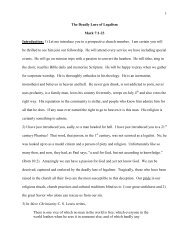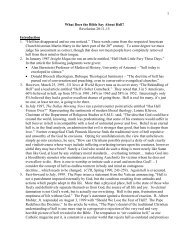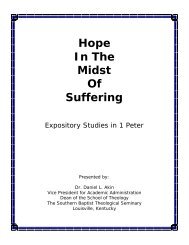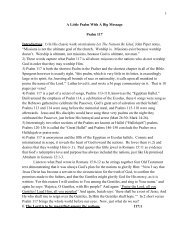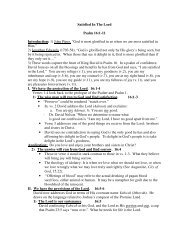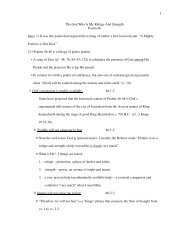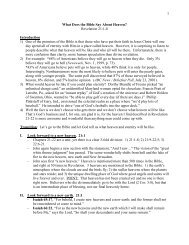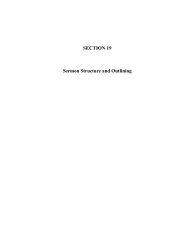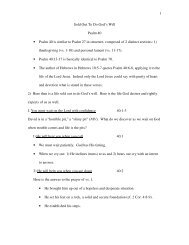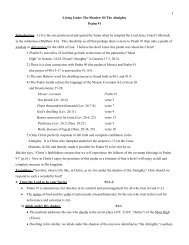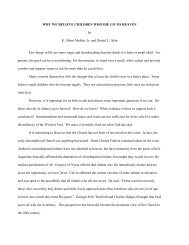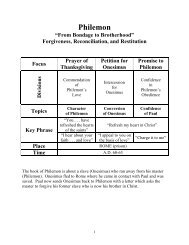2 Peter - Daniel Akin
2 Peter - Daniel Akin
2 Peter - Daniel Akin
You also want an ePaper? Increase the reach of your titles
YUMPU automatically turns print PDFs into web optimized ePapers that Google loves.
2 <strong>Peter</strong><br />
Author:<br />
The Apostle <strong>Peter</strong><br />
Date of Writing: c. A.D. 65–66<br />
Place of Writing: Probably Rome<br />
Purposes in Writing:<br />
1. To challenge the readers to grow in their<br />
knowledge of Jesus Christ (1:2-15)<br />
2. To reaffirm the truthfulness and the trustworthiness of the<br />
prophetic Word of God (1:16-21)<br />
3. To warn of the danger of false teachers and their<br />
destructive doctrines (2:1-22)<br />
4. To encourage watchfulness and steadfastness in light of<br />
our Lord’s certain return (3:1-18)
A Study of 2 <strong>Peter</strong><br />
Purpose: To warn against false teaching, doctrinal error, and moral compromise as<br />
we live in the last days.<br />
Date: A.D. 65-66<br />
Key Words: Lord Jesus Christ, Knowledge, Diligence, Destruction, Beloved,<br />
Remember/Remind, Corruption<br />
Tone: Urgent, Intense, Encouraging<br />
Spiritual Growth<br />
Doctrinal<br />
Compromise<br />
Eschatological<br />
Hope<br />
Introduction<br />
How can I grow in<br />
godliness?<br />
How can I<br />
recognize false<br />
prophets?<br />
How will it all end?<br />
Conclusion<br />
1:1-4<br />
Chapter 1<br />
Chapter 2<br />
Chapter 3<br />
3:14-18<br />
Warning<br />
Add to your faith.<br />
(v. 5)<br />
Know the truth.<br />
(v. 3)<br />
Be diligent!<br />
(v. 14)<br />
Promise<br />
“You will never<br />
stumble.” (v. 10)<br />
“God will deliver<br />
you.” (v. 9)<br />
“Jesus is coming!”<br />
(v. 12)<br />
Perspective Looking within Looking back Looking ahead<br />
3
Introduction to 2 <strong>Peter</strong><br />
Author:<br />
Simon <strong>Peter</strong> is the stated author of this letter (1:1). This affirmation is<br />
supported by the text of the epistle by the following evidence: (1) the<br />
use of the first person pronoun in the context of Jesus’ prediction of his<br />
death (cf. 1:14), (2) the claim to be an eyewitness of the transfiguration<br />
of Jesus (cf. 1:16-18), (3) the acknowledgement to the readers that this<br />
is his second epistle (3:1), (4) his references to Paul as “our beloved<br />
brother” (3:15), and (5) his honest admission that in Paul’s letters are<br />
“some things hard to understand” (3:16).<br />
External evidence for the authenticity of 2 <strong>Peter</strong> also exists,<br />
though it must be admitted, it is not as strong as it is for the first epistle.<br />
1 Clement (c. A.D. 95) and the Didache (c. A.D. 100) may allude to it.<br />
In the late second and early third centuries, support for its canonicity<br />
(inclusion in Holy Scripture) grows, though some doubted its<br />
genuineness. Eusebius (A.D. 265-340) classified the book as<br />
antilegomena or disputed (other N.T. books disputed but eventually<br />
recognized as divinely inspired include Hebrews, James, 2 and 3 John,<br />
Jude, and Revelation). By the end of the fourth century, the epistle was<br />
generally accepted by the vast majority of the Christian world. Modern<br />
critical scholars have attacked this book more than any other in the New<br />
Testament as to its authenticity. Many have judged it as<br />
pseudepigraphic (meaning a “false writing”), i.e., a forgery, and date it<br />
well after the time of <strong>Peter</strong>’s death (c. A.D. 67-68). Some would even<br />
date it in the second century. Most skeptical scholars do not wish to<br />
remove the book from its authoritative place in Holy Scriptures (though<br />
some do), but they argue that the style and vocabulary of 2 <strong>Peter</strong> is so<br />
different from that of 1 <strong>Peter</strong> that it rules out a common author. Some<br />
believe the differences to be so significant that if the two letters had<br />
been anonymous, no one would have ever thought to attribute them to a<br />
common authorship. How should we respond to these issues?<br />
There is indeed a difference in style. However, the real<br />
difference is between the Petrine epistles and the rest of the New<br />
Testament. The fact is no other book is as much like 1 <strong>Peter</strong> as 2 <strong>Peter</strong><br />
(with the exception of Jude). The differences that do exist may be<br />
explained by a change in subject matter, by time and circumstances of<br />
writing, and especially by the part played by an amanuensis (secretary).<br />
In 1 Pet. 5:12, <strong>Peter</strong> suggests the strong possibility that Silvanus (Silas)<br />
served as the amanuensis for this epistle. 2 <strong>Peter</strong> has no such reference.<br />
4
Perhaps some differences in style and vocabulary can be attributed to<br />
the service of Silvanus as an amanuensis for the writing of 1 <strong>Peter</strong>,<br />
whereas <strong>Peter</strong> himself (or some other secretary) is responsible for the<br />
actual and direct penning of 2 <strong>Peter</strong>. When a careful study and a<br />
balanced investigation is made, there is no compelling reason for<br />
rejecting 2 <strong>Peter</strong> as genuine. The letter should be viewed as authentic.<br />
It comes from the apostle whose name it carries.<br />
Date:<br />
The second epistle appears to have been written shortly after the first<br />
and from the same location, probably from Rome (cf. 1 Pet. 5:13 and<br />
the cryptic use of “Babylon” for Rome). Proper assignment then is c.<br />
A.D. 65-66, during the latter part of the reign of the infamous Roman<br />
emperor Nero (A.D. 54-68), and toward the end of <strong>Peter</strong>’s life (cf. 1:12-<br />
15).<br />
Recipients: The reference in 2 Pet. 3:1 to the present epistle as the second letter<br />
indicates that the recipients were the same believers who were<br />
addressed in 1 <strong>Peter</strong> (cf. 1 Pet. 1:1).<br />
Theme:<br />
A variety of subjects is discussed in 2 <strong>Peter</strong>, but all reaffirm the<br />
truthfulness of the apostolic witness and the need to be forewarned of<br />
the imminent danger of the testimony by false teachers. The book<br />
concludes with an eschatological note designed to encourage and fortify<br />
the faith of believers. 2 <strong>Peter</strong> is a short letter of just 61 verses and three<br />
chapters. Its message, however, is concise and clear: beware of false<br />
teachers, theological error and moral corruption as we live in the last<br />
days before Jesus comes again.<br />
Purposes: 1) To encourage spiritual growth (chapter 1)<br />
2) To counter false teaching (chapter 2)<br />
3) To foster watchfulness in light of our Lord’s certain return<br />
(chapter 3)<br />
5
Characteristics of Spiritual Teachers<br />
False<br />
Teacher<br />
Faithful<br />
Teacher<br />
1. Controlled by the flesh<br />
2. Immoral<br />
3. Slave of sin<br />
4. Starves sinners<br />
5. Destination: Lake of Fire<br />
1. Controlled by the Spirit<br />
2. Moral<br />
3. Slave of the Savior<br />
4. Feeds sinners<br />
5. Destination: Heaven<br />
The Relation of<br />
2 <strong>Peter</strong> and Jude:<br />
There is a close relationship between 2 <strong>Peter</strong> and Jude. The<br />
resemblances are largely between 2 Pet. 2:1-18; 3:1-3 and Jude 4-13,<br />
16-18. There are four possible explanations for this close<br />
resemblance. (1) Jude is dependent on 2 <strong>Peter</strong>; (2) 2 <strong>Peter</strong> is<br />
dependent on Jude; (3) Both letters were dependent on a common<br />
source; or (4) Common authorship. The majority view is that 2 <strong>Peter</strong><br />
is dependent on Jude. Since Jude is shorter, there seems to be no<br />
reason to suppose that it would have been published after 2 <strong>Peter</strong> if all<br />
the common points had been covered. Some also argue that Jude is<br />
more harsh, and that 2 <strong>Peter</strong> softens the tone. Jude makes use of<br />
apocryphal material, and <strong>Peter</strong> allegedly corrects this in his letter.<br />
However, it is certainly conceivable that Jude may have used 2 <strong>Peter</strong><br />
to meet his particular situation. Just because it is shorter does not<br />
mean that Jude could not have used the pertinent parts and adapted<br />
them to suit his own purpose. It is also possible that Jude saw the<br />
need to adopt a stronger approach as the threat of false teaching was<br />
growing stronger.<br />
It is quite probable that Jude makes a reference to 2 <strong>Peter</strong>. This is<br />
seen most clearly in Jude 17, which exhorts the readers to remember<br />
the apostles’ predictions and the words cited occur almost verbatim in<br />
2 Pet. 3:3. Further, it seems that Jude is experiencing what <strong>Peter</strong><br />
prophesied. <strong>Peter</strong> said false prophets were coming and Jude says<br />
6
that false prophets are here. This could also help to explain the<br />
harsher tone of Jude. Another reason to hold to Petrine priority is that<br />
it is more difficult to conceive of <strong>Peter</strong> (a well-known apostle) making<br />
use of a lesser known non-apostle, than it is to conceive of Jude<br />
referring to <strong>Peter</strong>.<br />
<br />
Comparing First and Second <strong>Peter</strong><br />
1 <strong>Peter</strong> 2 <strong>Peter</strong><br />
Major Focus:<br />
Hope in the midst of suffering<br />
Christology: The sufferings of Christ for<br />
our salvation and the example of His life.<br />
The day of salvation when Christ<br />
suffered, died and rose from the dead.<br />
Be encouraged in your present trials.<br />
We need hope to face our trials.<br />
Numerous similarities to Paul (especially<br />
Ephesians and Colossians)<br />
Major Focus:<br />
The danger of false teaching and<br />
practices<br />
Christology: The glory of Christ and the<br />
consummation of history at His return.<br />
The day of the Lord when Christ returns<br />
in judgment.<br />
Be warned of eschatological judgment.<br />
We need full knowledge to face error.<br />
Almost identical similarities to Jude<br />
(compare 2 <strong>Peter</strong> 2 with Jude 4-18)<br />
7
Outline of 2 <strong>Peter</strong><br />
I. Introduction<br />
II. The condition of the Christian 1:3-11<br />
1. The believer’s resources 1:3-4<br />
2. The believer’s needs 1:5-9<br />
3. The believer’s adequacy 1:10-11<br />
III. The authority for the Christian 1:12-21<br />
1. The need for teaching 1:12-15<br />
2. The apostles’ witness 1:16-18<br />
3. The divine origin of Scripture 1:19-21<br />
IV. The danger to the Christian 2:1-22<br />
1. The characteristics of false teachers 2:1-3<br />
2. The consequences of false teaching 2:4-10a<br />
3. The conduct of false teaching 2:10b-19<br />
4. The condemnation of false teachers 2:20-22<br />
V. The prospect for the Christian 3:1-6<br />
1. The purpose of this second epistle 3:1-2<br />
2. Scoffers in the last days 3:3-6<br />
3. End-time events 3:8-9<br />
4. Living in view of the future 3:10-12<br />
VI. Conclusion 3:14-18<br />
8
Until Then<br />
(Jesus is coming again: What should I do?)<br />
2 <strong>Peter</strong> 3:14-18<br />
I. Be diligent to maintain certain priorities 3:14<br />
1. Pursue peace<br />
2. Pursue purity<br />
II. Be devoted to meditate on our Master’s patience 3:15-16<br />
1. It expresses His heart 3:15 (cf. 3:9)<br />
2. It exposes the heretic 3:16 (cf. 2:1-2)<br />
III. Be determined to mark your position 3:17<br />
1. Remember what you were taught<br />
2. Remain where you stand<br />
IV. Be dedicated to magnify God’s praise 3:18<br />
1. Grow in grace daily<br />
2. Give God glory eternally<br />
9



